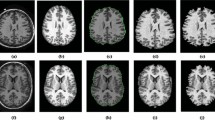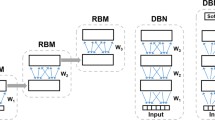Abstract
Schizophrenia (SZ) is a brain disorder that affects manifold cognitive domains which include language, memory, attention and executive functions. Magnetic resonance imaging is used to capture structural abnormalities in brain regions. Many studies have indicated brain region volume changes in Schizophrenia patients. In this work, an attempt has been made to analyze the schizophrenic subjects based on ventricle region using deep belief networks (DBNs). The effectiveness of the proposed method is evaluated on center of biomedical research excellence database. Initially, the ventricle region from the normal and SZ images is segmented using multiplicative intrinsic component optimization method. The DBN using different learning algorithms such as stochastic gradient descent (SGD), adaptive gradient (Adagrad) and root-mean-square propagation (RMSProp) is used to train the considered region. The effect of number of layers and the learning algorithm used to discriminate the normal and SZ subjects in DBN is analyzed. Then, the DBN model is evaluated on test set using accuracy, precision, sensitivity and specificity measures. The classification performance of the proposed system is analyzed using receiver operating characteristic curve. Further, the performance of DBN based on segmented ventricle is compared with region of interest (ROI) image that consists of ventricle along with other tissues. Here threefold validations are carried out for the same set of images. Results show that DBN with RMSProp learning with two hidden layers gives better performance compared to other learning methods such as SGD and Adagrad. In addition, DBN on segmented ventricle region gives least error compared to ROI image. DBN with segmented ventricle provides better classification accuracy of 90%. The proposed method achieves high area under the curve (0.899) for the segmented ventricle image, which clearly demonstrates its effectiveness. Thus, the DBN with RMSProp learning-based classification of segmented ventricle could be used as a supplement in the investigation of Schizophrenia.










Similar content being viewed by others
References
Pawan KS, Sarkar Ram (2015) A simple and effective expert system for schizophrenia detection. Int J Intell Syst Technol Appl 14(1):27–49
Frisoni GB, Fox NC, Jack CR, Scheltens P, Thompson PM (2010) The clinical use of structural MRI in Alzheimer disease. Nat Rev Neurol 6(2):67–77
Afsoon K, Gholam AHZ, Esmaeil SA (2015) Comparison of volumes of subcortical regions in Schizophrenia patients and healthy controls using MRI. In: Proceedings of the second international conference on pattern recognition and image analysis, Rasht, pp 1–5
Haijma SV, Van Haren N, Cahn W, Koolschijn PC, Hulshoff Pol HE, Kahn RS (2013) Brain volumes in Schizophrenia: a meta-analysis in over 18000 subjects. Schizophr Bull 39(5):1129–1138
Naren PR, Venkatasubramanian G, Arasappa Rashmi, Gangadhar N (2011) Relationship between corpus callosum abnormalities and schneiderian first-rank symptoms in antipsychotic naive Schizophrenia patients. J Neuropsychiatry Clin Neurosci 23(2):155–162
Zhao G, Denisova K, Sehatpour P, Long J, Gui W, Qiao J, Javitt DC, Wang Z (2016) Fractal dimension analysis of subcortical gray matter structures in Schizophrenia. PLoS ONE 11(10):e0164910
Sun Y, Chen Y, Collinson SL, Bezerianos A, Sim K (2017) Reduced hemispheric asymmetry of brain anatomical networks is linked to Schizophrenia: a connectome study. Cereb Cortex 27(1):602–615
Takayanagi Y, Takahashi T, Orikabe L, Mozue Y, Kawasaki Y, Nakamura K, Sato Y et al (2011) Classification of first-episode Schizophrenia patients and healthy subjects by automated MRI measures of regional brain volume and cortical thickness. PLoS ONE 6(6):e21047
Gaser C, Nenadic I, Buchsbaum BR, Hazlett EA, Buchsbaum MS (2004) Ventricular enlargement in Schizophrenia related to volume reduction of the thalamus, striatum, and superior temporal cortex. Am J Psychiatry 161(1):1–8
Del Re EC, Konishi J, Bouix S, Blokland GA, Mesholam-Gately RI, Goldstein J, Kubicki M, Wojcik J, Pasternak O, Seidman LJ, Petryshen T, Hirayasu Y, Niznikiewicz M, Shenton ME, McCarley RW (2016) Enlarged lateral ventricles inversely correlate with reduced corpus callosum central volume in first episode schizophrenia: association with functional measures. Brain Imaging Behav 10(4):1264–1273
Iwabuchi SJ, Liddle PF, Palaniyappan L (2015) Clinical utility of machine-learning approaches in schizophrenia: improving diagnostic confidence for translational Neuroimaging. Front Psychiatr 4(95):1–9
Xiaobing L, Yang Y, Wu F, Gao M, Xu Y, Zhang Y et al (2016) Discriminative analysis of schizophrenia using support vector machine and recursive feature elimination on structural MRI images. Medicine 95(30):e3973
Goulda IC, Shepherda AM, Laurensa KR, Cairns MJ, Carra VJ, Greena MJ (2014) Multivariate neuroanatomical classification of cognitive subtypes in Schizophrenia: a support vector machine learning approach. NeuroImage Clin 6:229–236
Akanksha J, Bharti R, Agrawal RK (2016) Combination of singular value decomposition and multivariate feature selection method for diagnosis of Schizophrenia using fMRI. Biomed Signal Process Control 27:122–133
Schwarz D, Kasparek T (2014) Brain morphometry of MR images for automated classification of first-episode schizophrenia. Inf Fusion 19:97–102
Janousova E, Schwarz D, Kasparek T (2015) Combining various types of classifiers and features extracted from magnetic resonance imaging data in schizophrenia recognition. Psychiatr Res Neuroimaging 232:237–249
Sayo AI, Jennings RG, Van Horn JD (2012) Study factors influencing ventricular enlargement in schizophrenia: a 20 year follow-up meta-analysis. Neuroimage 59(1):154–167
Kempton MJ, Stahl D, Williams SCR, DeLisi LE (2010) Progressive lateral ventricular enlargement in schizophrenia: a meta-analysis of longitudinal MRI studies. Schizophr Res 120:54–62
Eloy R, Oliver A, Cabezas M, Vilanovab JC, Rovirac A, Torrentad LR, Llado X (2014) MARGA: multispectral adaptive region growing algorithm for brain extraction on axial MRI. Comput Methods Programs Biomed 13(2):655–673
Li Chunming, John CG, Christos D (2014) Multiplicative intrinsic component optimization (MICO) for MRI bias field estimation and tissue segmentation. Magn Reson Imaging 32(7):913–923
Nara MP, George DCC, Tsang IR (2014) Semi-supervised clustering for MR brain image segmentation. Expert Syst Appl 41(4):1492–1497
Yunjie C, Zhao Bo, Jianwei Z, Yuhui Z (2014) Automatic segmentation for brain MR images via a convex optimized segmentation and bias field correction coupled model. Magn Reson Imaging 32(7):941–955
Ke Gan (2015) Automated segmentation of the lateral ventricle in MR images of human brain. In: Proceedings of IEEE international conference on digital signal processing, Singapore, pp 139–142
Kayalvizhi M, Kavitha G, Sujatha CM, Ramakrishnan S (2015) Analysis of anatomical regions in Alzheimer’s brain MR images using level sets and Minkowski functional. J Mech Med Biol 15(2):1540024(1)–1540024(7)
Julazadeh A, Alirezaie J, Babyn P (2012) A novel automated approach for segmenting lateral ventricle in MR images of the brain using sparse representation classification and dictionary learning. Proc Int Conf Inf Sci, Signal Process Appl: Main Tracks 978(1):889–893
Martin L, Lars K, Amy L (2012) Sleep stage classification using unsupervised feature learning. Adv Artif Neural Syst 107046:1–9
Ahmed MA, Ayman ME (2016) Breast cancer classification using deep belief networks. Expert Syst Appl 46:139–144
Heung-II S, Dinggang S (2013) Deep learning based feature representation for AD/MCI Classification. Med Image Comput Comput-Assist Interv 16(02):583–590
Nima T, Kenji S (2017) Comparing two classes of end-to-end machine-learning models in lung nodule detection and classification: MTANNs vs CNNs. Pattern Recognit 63:476–486
Sergey MP, Devon RH, Salakhutdinov R, Vince DC (2014) Deep learning for neuroimaging: a validation study. Front Neurosci 8(229):1–11
Chen Q, Dong DL, Shao LC, Wang YP (2016) The effective diagnosis of schizophrenia by using multi-layer RBMs deep networks. Proc IEEE Int Conf Bioinform Biomed Washington DC. https://doi.org/10.1109/BIBM.2015.7359751
Jun Q, Javier T (2016) Deep multi-view representation learning for multi-modal features of the Schizophrenia and Schizo-affective Disorder. Proc IEEE Int Conf Acoust, Speech Signal Process Shanghai. https://doi.org/10.1109/ICASSP.2016.7471816
Eduardo C, Devon HR, Sergey MP, Laurent D, Jessica AT, Vince DC (2016) Deep independence network analysis of structural brain imaging: application to Schizophrenia. IEEE Trans Med Imaging 35(7):1729–1740
Junghoe K, Vince DC, Eunsoo S, Jong HL (2016) Deep neural network with weight sparsity control and pre-training extracts hierarchical features and enhances classification performance: evidence from whole-brain resting-state functional connectivity patterns of Schizophrenia. NeuroImage 124:127–146
Pinaya WHL, Gadelha Ary, Doyle OM, Noto Cristiano, Zugman A, Cordeiro Q, Jackowski AP, Bressan RA, Sato JR (2016) Using deep belief network modelling to characterize differences in brain morphometry in schizophrenia. Sci Rep 6(38897):1–9
Çetin M, Christensen F, Abbott C, Stephen J, Mayer A, Cañive J, Bustillo J, Pearlson G, Calhoun VD (2014) Thalamus and posterior temporal lobe show greater inter-network connectivity at rest and across sensory paradigms in schizophrenia. NeuroImage 97:117–126
Kangyu N, Xavier B, Tony C, Selim E (2009) Local histogram based segmentation using the Wasserstein Distance. Int J Comput Vision 84(1):97–111
Soowoon K, Park B, Seop BS, Yang S (2016) Deep belief network based statistical feature learning for fingerprint liveness detection. Pattern Recogn Lett 77:58–65
Yadan L, Feng Z, Chao Xu (2014) Facial expression recognition via deep learning. IETE Tech Rev 32(5):347–355
Hinton GE, Osindero S, Teh YW (2006) A fast learning algorithm for deep belief nets. Neural Comput 18:1527–1554
Sebastian R (2016) An overview of gradient descent optimization algorithms. arXiv:1609.04747
Sutskever I, Martens J, Dahl G, Hinton G (2013) On the importance of initialization and momentum in deep learning. In: Proceedings of the 30th international conference on machine learning (ICML-13), 1139–1147
Duchi J, Hazan E, Singer Y (2011) Adaptive subgradient methods for online learning and stochastic optimization. J Mach Learn Res 12:2121–2159
Tieleman T, Hinton G (2012) Lecture 6.5-rmsprop: divide the gradient by a running average of its recent magnitude. COURSERA: Neural Netw Mach Learn 4:26–31
Larochelle H, Bengio Y, Louradour J, Lamblin P (2009) Exploring strategies for training deep neural networks. J Mach Learn Res 10:1–40
Srivastava N, Hinton G, Krizhevsky A, Sutskever I, Salakhutdinov R (2014) Dropout: a simple way to prevent neural networks from overfitting. J Mach Learn Res 15:1929–1958
Acknowledgements
The first author, M. Latha, is receiving Anna Centenary Research Fellowship from Anna University (CFR/ACRF/2015/20, Dated: 21.01.2015) for her research work.
Author information
Authors and Affiliations
Corresponding author
Ethics declarations
Conflict of interest
The authors declare that they have no conflict of interest.
Ethical approval
This article does not contain any studies with animals performed by any of the authors.
Informed consent
This study includes the images from publicly available database, and the database has been cited.
Rights and permissions
About this article
Cite this article
Latha, M., Kavitha, G. Detection of Schizophrenia in brain MR images based on segmented ventricle region and deep belief networks. Neural Comput & Applic 31, 5195–5206 (2019). https://doi.org/10.1007/s00521-018-3360-1
Received:
Accepted:
Published:
Issue Date:
DOI: https://doi.org/10.1007/s00521-018-3360-1




